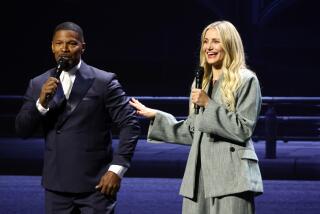CABLE: NEW FRONTIER GROWS UP : It Must Now Turn to New Programming, Technologies to Secure Its Future
Cable television, the former wundertech industry that gave the world music videos and all-night news, faces some pats on the back and some sharp pokes in the ribs this week.
Tonight, there will be self-congratulation as the Awards for Cable Excellence (ACE) are handed out in black-tie ceremonies at the Beverly Theatre that are scheduled for telecast on the West Coast next Monday.
For three days starting Wednesday, cable programmers and operators will hear some tough talk about “Meeting the Challenge” during the Western Cable Television Show at the Anaheim Convention Center.
Though different in their intent and in their overall level of exuberance, both events will reflect the same harsh reality: The years of blister-paced subscribership are over. The cable industry, facing a diminishing number of new geographical areas to conquer and a videocassette market that has taken a large bite out of its business, now must turn to new programming and new technologies to secure its future.
Thus, the ACE Awards this year for the first time are being presented under the aegis of the National Academy of Cable Programming, established nine months ago by the National Cable Television Assn. to celebrate cable TV’s efforts in programming shows that can’t be found in movie theaters, on videocassette or on commercial TV. These include concerts, sporting events and news specials; series such as Showtime’s “Faerie Tale Theatre”; children’s programming like the Disney Channel’s “Welcome to Pooh Corner,” and dramatic offerings like Home Box Office’s made-for-pay movie “Sakharov” and the 30-part “Tenko” now on the Arts & Entertainment Network.
The cable industry this year has pumped enough money into tonight’s event to nearly double the $300,000 or so Ted Turner’s WTBS supplies to mount the event, which the Atlanta superstation also telecasts separately in prime time on the East and West coasts.
Meanwhile, at the three-day cable show, sponsored by the California Cable Television Assn., buzzwords will include “pay-per-view,” “scrambling” and “addressability.” All are technological weapons designed to stem the VCR encroachment and rid the system of non-paying users.
Not all of cable’s problems are equally prevalent throughout the industry. Even as pay services such as HBO and Showtime wind up this year with little or no growth compared to 1984, basic services such as USA Network, ESPN and MTV--advertising-supported and available to cable subscribers at no extra charge--continue to show healthy increases in subscribership and ad revenues.
“Cable is no longer the generic thing it used to be,” said industry analyst Paul Kagan. In contrast to the days of unbridled growth, changes now are reflected city to city, Kagan noted, with some systems still expanding while others “have reached a saturation level.”
All of these developments reflect the maturing of a business that now is available to about 70% of American households. Cable has changed profoundly since the beginning of this decade, when HBO and Showtime/The Movie Channel promised a steady supply of fresh theatrical films, and basic services like the Cable Health Network offered a special-interest alternative to broadcasting that they called “narrowcasting.”
Today, movies are available in videocassette at least six months in advance of being featured on pay cable. And the basic services in many cases have broadened their content to reach an expanded viewership.
Yet, even if cable has fallen short of some of its initial promise, it has had a far-reaching impact on television and pop culture.
MTV almost single-handedly turned the term video into a noun and rejuvenated a flagging music business. It is also credited with inspiring the hot colors and accelerated clip, first of 30-second commercials and then of “Miami Vice,” followed by countless look- and sound-alikes on movies and TV.
Ted Turner’s Cable News Network also influenced the networks. “After Turner did it, all three networks tried to do all-night news,” said Greg Nathanson, vice president of programming for Wometco Broadcasting and scheduled speaker on the topic of “Competition for Viewing Time.”
And pay cable, with its once virtually nonstop movie offerings, is credited with nudging ABC, CBS and NBC into heavy production of their own made-for-TV movies and miniseries. “I think the spread of pay TV made network TV better,” said HBO’s Seth Abraham, senior vice president for program operations and sports.
Abraham can even trace the turnaround to a single evening in February, 1984: The networks simultaneously aired “Chariots of Fire” (NBC), “Star Wars” (CBS) and “My Mother’s Secret Life” (ABC). The latter show, a made-for-TV movie starring Loni Anderson, “buried” its feature-film competition, Abraham recalls. “It was virginal, it was fresh programing. For all the people who had pay TV, it was new.”
Pay TV, which saw some of its movie ratings decline early this year, is determined not to let its viewership continue to erode at the hands of videocassettes. The last few years have seen a substantial increase in what Showtime executive vice president Peter Chernin calls “video-proof programming” in the form of series, made-for-pay movies and music and sports events.
Those categories now account for between 35% and 40% of the schedules at HBO and Showtime--and they’d be even more prevalent if theatrical releases weren’t the more economical alternative. HBO’s Premiere Films--original movies, such as the current “Fortress,” starring Rachel Ward--regularly draw more viewers than the channel’s feature film fare. At Showtime, more than half of the top 10 shows each month are original programs and special events.
“Movies are still the locomotive that drives the train that is pay TV,” Abraham said. “But the quality and quantity of cars behind that train are increasing.”
Some other trends and developments cable industry representatives will be discussing in the next few days:
--Pay-per-view and addressability: The basic premise behind pay-per-view is that anyone willing to spend $2 or $3 to rent a videocassette should be willing to spend a dollar or two more to skip the round trip to the video store. Such a service can exist only where cable systems are addressable , that is, wired so that the cable office essentially has an on-off switch for each home in the system area. Though only one-fourth of all cable homes are addressable, two pay-per-view systems were started up last week. They are Viewer’s Choice, a subsidiary of Showtime, and Request Television, founded by former Showtime president Jeffrey C. Reiss.
Addressability has the added benefit for cable operators of making it impossible for users to gain access to pay services via switches on the cable lines, as is done frequently--and illegally--in non-addressable areas.
Pay-per-view, incidentally, is not entirely new: The Dodgers experimented with a coin-box regulating viewership of home games shortly after moving to Los Angeles in the ‘50s.
--Scrambling: An estimated 1 million satellite dishes now are in operation, bypassing cable operators to bring pay and other channels into the home. As a result, “We’re losing millions of dollars a year to people who are unlawfully receiving our signals,” said HBO’s Abraham. The solution is scrambling, and both HBO and Showtime will either test or implement the encryption of their satellite signals beginning next month. Cable operators will be able to decode those signals using special equipment not available to home dish owners. Showtime’s Chernin expects “some incremental growth based on people who are currently not paying” for the service because they get it via dish.
--Deregulation and must-carry: The lifting of these two key government restrictions could be a boon to cable operators but a detriment to certain programming services. Deregulation has allowed a rate increase that puts higher basic service fees in cable operators’ pockets. But industry analyst Kagan believes it also has prompted some users to drop their relatively costly pay-channel subscription--or perhaps the second or third such channel. Pay-TV executives believe this has contributed to their flattened growth rate.
Cable operators also soon will be able to drop locally broadcast channels they currently “must carry”--or may charge those channels for the privilege of being piped into homes via cable. Industry observers are divided on this issue. The dropping of less-viewed stations could create new and more competitive alternatives for the consumer. But it could also eliminate from the cable box stations such as local Public Broadcasting Service affiliates, many of whom broadcast on UHF and rely on cable to fully reach their communities.
--Marketing: With the boom days over, cable services can no longer grow, as one executive put it, “just by answering the telephone” and signing up new subscribers. HBO successfully reversed its early ’85 decline in subscribership in part via an aggressive marketing campaign touting its “All-Star Summer,” “Super Fall” and “Red Hot Winter.” “These are $100-million campaigns,” Abraham said, with about $15 million per campaign going to outside advertising, $1 million to on-air promotion and the rest to film and program license fees.
Showtime’s Chernin believes that stronger marketing would enable “the cable industry as a whole (to) do a better job of combating home video.” While home video is still “a hit title business,” Chernin said, cable could and should be promoting its “much wider variety” of programming.
More to Read
The biggest entertainment stories
Get our big stories about Hollywood, film, television, music, arts, culture and more right in your inbox as soon as they publish.
You may occasionally receive promotional content from the Los Angeles Times.










